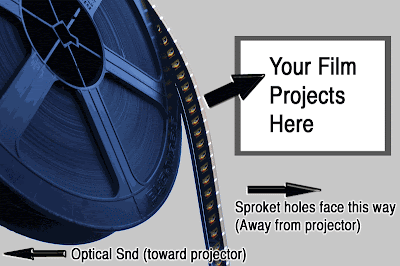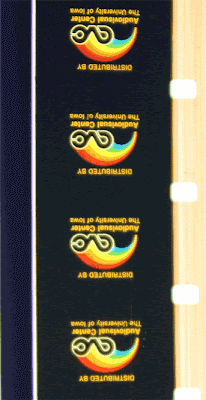
When building reels for Assignment 1, the elements project, it is important to have your film wound properly. This is especially the case with single perf (sprocket holes only on one side) film. Otherwise, the sprocket wheel's teeth can chew up your film.
*Note the above diagram*
The film is coming off the feed reel ~ over the reel ~ and the sprocket holes face right (away from the projector's body). The optical soundtrack faces left (toward the projector's body).
It is also important to note that for any non-abstract images, writing and animation, you should see the images coming off the film reel facing UPSIDE DOWN AND BACKWARDS.
~ Keep in mind though, your perspective to the film reel should be as in the above diagram - with the film coming off the top of the reel AWAY from you.~
This will insure that the images will be projected right side up and forwards. Notice in the below cross-section of the above diagram that the words "DISTRIBUTED BY" are not only upside down, but backwards and that the rainbow in the logo is likewise upside down.

*************************
As for stringing the separate strips of your elements project together, you should start with your reel. Then wedge your TAIL leader into a slit in the reel. You should build in the following order:
REEL < TAIL < 4TH ELEMENT < 3RD ELEMENT < 2ND ELEMENT < 1ST ELEMENT < HEAD LEADER




The reel, tail and head leader fall in a fixed order with the elements in between. Of course, you should consider the rhythm and quality of each of your elements and determine in which order the elements should fall.
PLEASE DOUBLE SPLICE ALL ELEMENTS TOGETHER. (This means to tape both the front and reverse side of two adjoining filmstrips). Make sure that the strip ends are free of dust, grit, oil, etc. so that the splicing tape may stick.
SINGLE SPLICE (tape only on one side) the HEAD leader on filmstrip. Note that the HEAD leader I have given you is longer that the tail to allow enough strip to load through the projector and wind onto the take-up reel - so that your first images don't get cut off from view.
In general your film must be DRY (so as not to rust the film gate) and relatively clean. Pat all of your elements with paper towels (don't rub) so as to remove as much oil and dirt as possible.







































